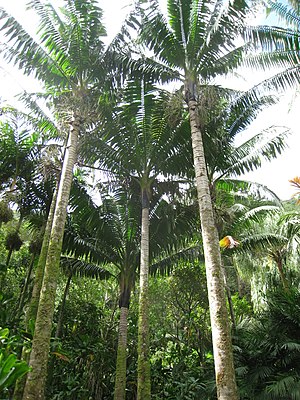Neoveitchia
| Neoveitchia | ||||||||||||
|---|---|---|---|---|---|---|---|---|---|---|---|---|

|
||||||||||||
| Systematics | ||||||||||||
|
||||||||||||
| Scientific name | ||||||||||||
| Neoveitchia | ||||||||||||
| Becc. |
Neoveitchia is a genus of palm that is nativeto the Pacific archipelagos of Vanuatu and Fiji .
features
The representatives are medium-sized, single-stemmed palms with pinnate leaves. They are unarmed, bloom several times and are single sexed ( monoecious ). The trunk is erect, glabrous and has conspicuous, ring-shaped leaf scars .
The number of chromosomes is unknown (as of 2008).
leaves
The leaves are pinnate and leave a smooth scar when they fall off. The leaf sheath tears open opposite the petiole and does not form a clear crown shaft. Scales are scattered on the vagina, the opening is irregularly fibrous. The petiole is flattened or slightly furrowed on the top, rounded on the underside. It is also scattered with scales. The rachis is curved, densely spotted on the underside, densely fuzzy hairy on the upper side. The numerous leaflets are regular, simply folded, pointed and have noticeably thickened leaf margins. The top is bald, the underside is slightly hairy near the base along the midrib.
Inflorescences
The inflorescences are under the leaves and are triply branched. The peduncle is winged and slightly swollen at the base, but it quickly narrows. Distally, it is approximately circular in cross section. The cover sheet sits near the base of the stem. It is tubular, flattened, distinctly two-keeled and tears at the tip for a long time of the anthesis , while it is still enclosed in the leaf sheath of the bract. The bract on the inflorescence stalk is about twice as long as the cover sheet, beaked, tubular and initially completely encloses the inflorescence. For anthesis it tears open lengthways and then falls off. There are one (or two) more, more triangular bracts.
The inflorescence axis is about the same length as the stem. The bracts are spiraling here. They are small and triangular. The side axes of the first order are bare in the lower area. The flower-bearing axes (rachillae) are rather stiff, curved to drooping and have rather few, distant flower triads. In the triad, the two male flowers are more distal to the female, instead of the lateral arrangement common in other genera. At the top of each rachilla there are about seven vertical rows of flower pits, each of which in turn houses a vertically arranged pair of male flowers. This male part of the rachilla falls off at the fruiting time. The bracts of the flowers are small and lie in the pits.
blossoms
The male flowers are asymmetrical. Flowers from triads have a flattened flower stalk, those from flower pairs are sessile. The three sepals are strongly keeled or winged, not overgrown and strongly imbricat . More often, one sepal is free, the other two are fused over three quarters of their length to form a double-keeled, pre-leaf-like structure. The three petals are free, triangular to oval, valvate and smooth. There are six stamens . Their stamens are rather short, fleshy, the anthers are short, rectangular, medifix, latrors with a broad connective . The rudiment of the pistil is columnar and as long as the stamens. The pollen is ellipsoidal, asymmetrical and has a distal sulcus as a germ opening. The longest axis measures 46 to 58 microns.
The female flowers are significantly larger than the male and almost spherical. The three sepals are free and overlap widely. The three petals are free, broadly overlapping with the exception of the small, triangular, valvate tips. The three staminodes are very small, triangular and tooth-shaped. The gynoeceum is single-compartment with an ovule . It is egg-shaped. The three scars are very small and curved backwards.
Fruits and seeds
The fruit is ellipsoidal, rather large and turns reddish-yellow when ripe. The flower shell is retained until ripe, with the remnant of the stigma at the tip of the fruit. The exocarp is smooth, the mesocarp is fleshy with numerous longitudinal fibers. The endocarp is thin, bony and sits close to the semen. The seed has an elongated hilum (navel) that runs almost the entire length of the seed. The raphe is branched and anastomosing . The endosperm is homogeneous.
Systematics and distribution
The genus Neoveitchia Becc. is placed within the family Arecaceae in the subfamily Arecoideae , Tribus Areceae and Subtribus Carpoxylinae .
In the World Checklist of Selected Plant Families of the Royal Botanic Gardens, Kew , the following types are recognized:
- Neoveitchia brunnea Dowe is endemic to Vanuatu . It grows in rainforests with very high levels of precipitation on red clay soil at around 300 m above sea level.
- Neoveitchia storckii (H. Wendl.) Becc. is limited to a very small area in Natasiri Province on Viti Levu ( Fiji ). It grows in secondary forest on alluvial plains and nearby hills. However, their locations have largely given way to agriculture.
supporting documents
- John Dransfield, Natalie W. Uhl, Conny B. Asmussen, William J. Baker, Madeline M. Harley, Carl E. Lewis: Genera Palmarum. The Evolution and Classification of Palms . Second edition, Royal Botanic Gardens, Kew 2008, ISBN 978-1-84246-182-2 , pp. 538f.
Individual evidence
- ↑ Rafaël Govaerts (ed.): Neoveitchia. In: World Checklist of Selected Plant Families (WCSP) - The Board of Trustees of the Royal Botanic Gardens, Kew . Retrieved May 31, 2010.
Web links
- Neoveitchia on the homepage of the Fairchild Tropical Botanic Garden